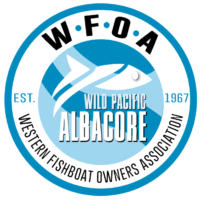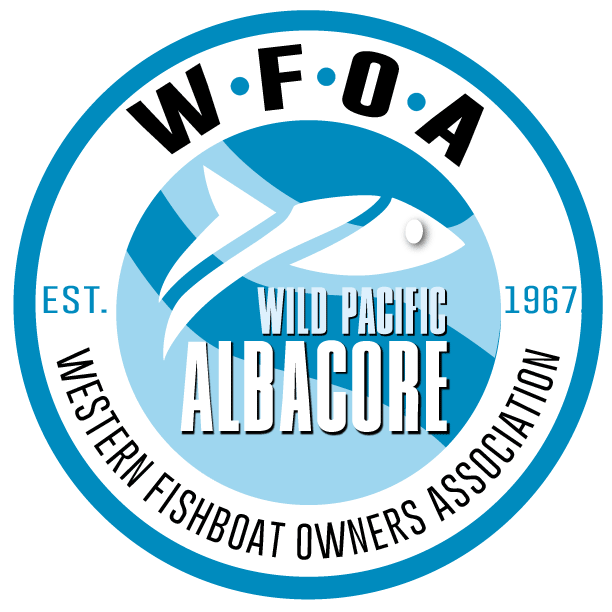FREQUENTLY ASKED QUESTIONS:
How large is the U.S. albacore fleet and how many fish do they land? Roughly 600-800 vessels land albacore between June and October each season, with probably 20 percent of the boats landing 80 percent of the catch in Washington, Oregon, and California. This has been the average number range since the 1980s. In 1968 about 2,300 vessels made landings. Average annual catch over the past 40 years has been between 11,000 and 15,000 tons.
What is the status now? Unfortunately the catch has diminished over the past 3 years to about 40% of historical average which could be a result of ocean conditions, climate, catchability, forage fish displacement and other causes. The International Science Committee says that the stock is not overfished in the South and North Pacific.
I heard WFOA is promoting limited entry for the fleet. Is this true? Not at all. WFOA believes in keeping the fishery sustainable and has been deeply involved in international and federal management since 1996. Stock assessments as recent as 2020 show the albacore stocks in the North Pacific are in good shape. WFOA believes, however, that standard science-based biological reference points should be adopted by all Regional Fisheries Management Organizations including the WCPFC and the IATTC.
What is WFOA’s actual position on efforts toward limited entry control for albacore? WFOA does not currently support (or see as necessary) limited entry on the albacore troll fishery. If a new international stock assessment shows problems in the future, the U.S. fleet, which is shrinking by attrition, should not unilaterally take on efforts at catch control. WFOA believes a sound multilateral approach would be best, undertaken by all countries and RFMOs with landings equally and fairly, as well as addressing factors such as IUU fishing.
Is WFOA an exclusive offshore large vessel association? No, not at all. Western Fishboat Owners’ Association vessels range from 30 to 100 feet in length, with the average around 55 feet. The vessels pack an average of 30 tons of frozen albacore, while some are iced/fresh vessels. About 80 percent of the WFOA members fish for other species during the year. These include crab, salmon, shrimp, swordfish, urchins, groundfish, halibut, and black cod.
Is the majority of the WFOA board made up of large offshore vessels? No. There are currently 17 board members, all but two of whom operate their own vessels during the season. Of the 17 directors, 15 have vessels under 60 feet in length.
Why do the large vessel owners and the same people always get on the board? Board members are elected each year for two-year terms at the spring directors’ meetings, usually in March. Any paid-up member can run for director and would most likely be welcomed. The number of directors in each district is allocated by the number of regular members on December 31 of the preceding year.
Doesn’t WFOA sell only to the U.S. canners? No. Up until 1998, about 90 percent of the catch was purchased by the three major U.S. canners, Bumble Bee, Chicken of the Sea, and Star Kist. Today virtually no U.S. troll albacore is purchased by them. Most albacore landed by U.S. trollers is exported to Spain and Asia, but an increasing amount (35 percent in 2013) is being sold domestically via custom canning and other value-added products. WFOA has worked hard on increasing and expanding this U.S. market — since 2008 WFOA has spent over $250,000 on public outreach to expand the domestic market in all phases. Members have greatly contributed to this effort — Wild Planet Foods, for example, has secured a large domestic market with retailers including Costco resulting in a greater percentage of the total catch being sold here at home.
Are the “U.S.” canners really U.S.? Not any longer — most have changed ownership numerous times in the past 10 years. Thailand, Korea, and Canada are now in ownership or partial ownership of these three major businesses.
WFOA used to have a fish report on SSB that was very useful to coastal boats. What happened? The regular SSB report began in the 1980s and worked very well as a way to disseminate information to the fleet on catches, market, regulations, and safety information. However, and somewhat unfortunately, times have changed. Code groups that began also in the 1980s with salmon became the norm in the albacore fleet. As high-tech transmission and receiving devices (such as satellite email and phones) became more common, the situation went totally underground. WFOA is still striving to get information out by alternative means. WFOA now has established an email list directly to vessels with systems such as Skymate, Oceans and others. We can also send text messages to Globalstar phones.
WFOA used to have water temp charts. Where are these? These used to come out of Ocean Eye and were faxed. AFRF used to pay for them when they were experimental … now they have gone to subscriptions for boats, and they get colored charts in 10th of degrees via email to the boats.
I sell all my albacore directly to the public or to custom processors. Why should I be involved in WFOA? WFOA has taken on a new direction aimed at marketing albacore to high-end and quality-conscious U.S. consumers. This marketing bypasses the payment of overseas shipping costs, and at the same time gives the U.S. consumer expanded access to our local, wild, and sustainably caught product. WFOA has spent a considerable amount of money on this and promotes all U.S. troll and baitboat albacore tuna domestically. WFOA also was certified as sustainable and well-managed in 2009 by the Marine Stewardship Council (MSC) to cover all U.S. troll and pole albacore vessels. In 2013 WFOA and the American Albacore Fishing Association (AAFA) merged certificates into one covering ALL pole and troll in the North and South Pacific. See the Wild Pacific Albacore site for more details.
Why do the U.S. and WFOA want foreign fishermen (Canadians) in the U.S. zone? WFOA and AAFA since late 2011 worked together to get a handle on this increasing problem. The U.S. and Canada established an access agreement back in 1981 when the Canadian fleet was very limited, and it worked well until there was a major shift of Canadian albacore boats into the United States EEZ starting in 1996. There have been three attempts to ratchet down the effort through U.S./Canada negotiations of the governments. It all came to a head in 2012 when the fishing regime under the treaty was suspended for the 2012 season. The governments put the regime back in place in 2013 for one year at a reduced number of vessels and stated that a phase-out of the remaining treaty was started. In 2014 a new 3-year regime was negotiated allowing 45 Canadian boats in U.S. waters and historic levels of U.S. boats into Canada. If you have a question on this please email it to WFOA and we will post it with an answer.

